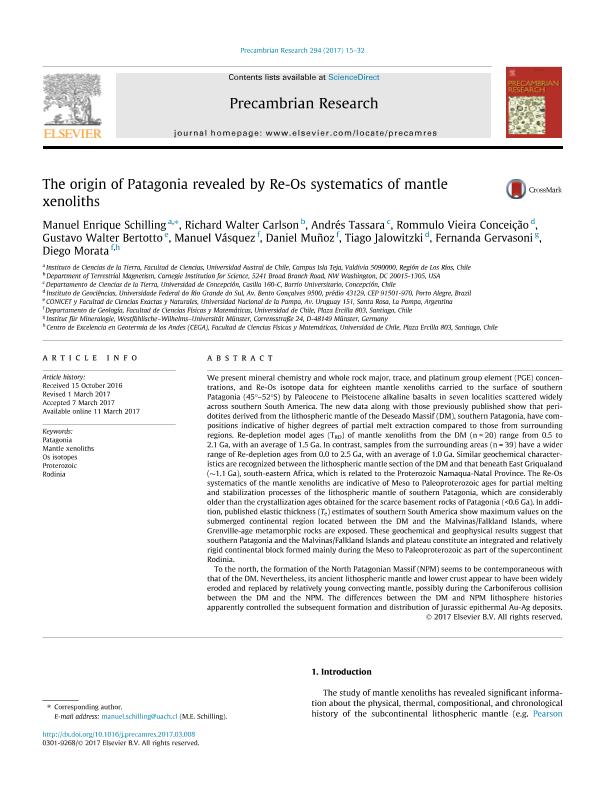Mostrar el registro sencillo del ítem
dc.contributor.author
Schilling, Manuel Enrique
dc.contributor.author
Carlson, Richard Walter
dc.contributor.author
Tassara, Andrés
dc.contributor.author
Conceição, Rommulo Vieira
dc.contributor.author
Bertotto, Gustavo Walter

dc.contributor.author
Vásquez, Manuel
dc.contributor.author
Muñoz, Daniel
dc.contributor.author
Jalowitzki, Tiago
dc.contributor.author
Gervasoni, Fernanda
dc.date.available
2017-06-30T19:12:19Z
dc.date.issued
2017-06
dc.identifier.citation
Schilling, Manuel Enrique; Carlson, Richard Walter; Tassara, Andrés; Conceição, Rommulo Vieira; Bertotto, Gustavo Walter; et al.; The origin of Patagonia revealed by Re-Os systematics of mantle xenoliths; Elsevier Science; Precambrian Research; 294; 6-2017; 15-32
dc.identifier.issn
0301-9268
dc.identifier.uri
http://hdl.handle.net/11336/19304
dc.description.abstract
We present mineral chemistry and whole rock major, trace, and platinum group element (PGE) concentrations, and Re-Os isotope data for eighteen mantle xenoliths carried to the surface of southern Patagonia (45°–52°S) by Paleocene to Pleistocene alkaline basalts in seven localities scattered widely across southern South America. The new data along with those previously published show that peridotites derived from the lithospheric mantle of the Deseado Massif (DM), southern Patagonia, have compositions indicative of higher degrees of partial melt extraction compared to those from surrounding regions. Re-depletion model ages (TRD) of mantle xenoliths from the DM (n = 20) range from 0.5 to 2.1 Ga, with an average of 1.5 Ga. In contrast, samples from the surrounding areas (n = 39) have a wider range of Re-depletion ages from 0.0 to 2.5 Ga, with an average of 1.0 Ga. Similar geochemical characteristics are recognized between the lithospheric mantle section of the DM and that beneath East Griqualand (∼1.1 Ga), south-eastern Africa, which is related to the Proterozoic Namaqua-Natal Province. The Re-Os systematics of the mantle xenoliths are indicative of Meso to Paleoproterozoic ages for partial melting and stabilization processes of the lithospheric mantle of southern Patagonia, which are considerably older than the crystallization ages obtained for the scarce basement rocks of Patagonia (<0.6 Ga). In addition, published elastic thickness (Te) estimates of southern South America show maximum values on the submerged continental region located between the DM and the Malvinas/Falkland Islands, where Grenville-age metamorphic rocks are exposed. These geochemical and geophysical results suggest that southern Patagonia and the Malvinas/Falkland Islands and plateau constitute an integrated and relatively rigid continental block formed mainly during the Meso to Paleoproterozoic as part of the supercontinent Rodinia. To the north, the formation of the North Patagonian Massif (NPM) seems to be contemporaneous with that of the DM. Nevertheless, its ancient lithospheric mantle and lower crust appear to have been widely eroded and replaced by relatively young convecting mantle, possibly during the Carboniferous collision between the DM and the NPM. The differences between the DM and NPM lithosphere histories apparently controlled the subsequent formation and distribution of Jurassic epithermal Au-Ag deposits.
dc.format
application/pdf
dc.language.iso
eng
dc.publisher
Elsevier Science

dc.rights
info:eu-repo/semantics/openAccess
dc.rights.uri
https://creativecommons.org/licenses/by-nc-sa/2.5/ar/
dc.subject
Patagonia
dc.subject
Mantle Xenoliths
dc.subject
Os Isotopes
dc.subject
Proterozoic
dc.subject
Rodinia
dc.subject.classification
Geología

dc.subject.classification
Ciencias de la Tierra y relacionadas con el Medio Ambiente

dc.subject.classification
CIENCIAS NATURALES Y EXACTAS

dc.title
The origin of Patagonia revealed by Re-Os systematics of mantle xenoliths
dc.type
info:eu-repo/semantics/article
dc.type
info:ar-repo/semantics/artículo
dc.type
info:eu-repo/semantics/publishedVersion
dc.date.updated
2017-06-29T13:59:38Z
dc.journal.volume
294
dc.journal.pagination
15-32
dc.journal.pais
Países Bajos

dc.journal.ciudad
Ámsterdam
dc.description.fil
Fil: Schilling, Manuel Enrique. Universidad Austral de Chile. Facultad de Ciencias. Instituto de Ciencias de la Tierra; Chile
dc.description.fil
Fil: Carlson, Richard Walter. Carnegie Institution for Science; Estados Unidos
dc.description.fil
Fil: Tassara, Andrés. Universidad de Concepción; Chile
dc.description.fil
Fil: Conceição, Rommulo Vieira. Universidade Federal do Rio Grande do Sul; Brasil
dc.description.fil
Fil: Bertotto, Gustavo Walter. Consejo Nacional de Investigaciones Científicas y Técnicas; Argentina. Universidad Nacional de La Pampa. Facultad de Ciencias Exactas y Naturales; Argentina
dc.description.fil
Fil: Vásquez, Manuel. Universidad de Chile. Facultad de Ciencias Físicas y Matemáticas. Departamento de Geología; Chile
dc.description.fil
Fil: Muñoz, Daniel. Universidad de Chile. Facultad de Ciencias Físicas y Matemáticas. Departamento de Geología; Chile
dc.description.fil
Fil: Jalowitzki, Tiago. Universidade Federal do Rio Grande do Sul; Brasil
dc.description.fil
Fil: Gervasoni, Fernanda. Westfalische Wilhelms Universitat; Alemania
dc.journal.title
Precambrian Research

dc.relation.alternativeid
info:eu-repo/semantics/altIdentifier/doi/http://dx.doi.org/10.1016/j.precamres.2017.03.008
dc.relation.alternativeid
info:eu-repo/semantics/altIdentifier/url/http://www.sciencedirect.com/science/article/pii/S0301926816304594
Archivos asociados
